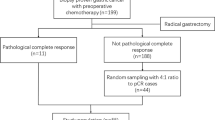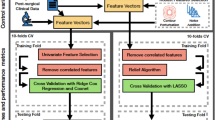Abstract
Objectives
The value of adding radiotherapy (RT) is still unclear for patients with gastric cancer (GC) after D2 lymphadenectomy. The purpose of this study is to predict and compare the overall survival (OS) and disease-free survival (DFS) of GC patients treated by chemotherapy and chemoradiation based on contrast-enhanced CT (CECT) radiomics.
Methods
A total of 154 patients treated by chemotherapy and chemoradiation in authors’ hospital were retrospectively reviewed and randomly divided into the training and testing cohorts (7:3). Radiomics features were extracted from contoured tumor volumes in CECT using the pyradiomics software. Radiomics score and nomogram with integrated clinical factors were developed to predict the OS and DFS and evaluated with Harrell's Consistency Index (C-index).
Results
Radiomics score achieved a C index of 0.721(95%CI: 0.681–0.761) and 0.774 (95%CI: 0.738–0.810) in the prediction of DFS and OS for GC patients treated by chemotherapy and chemoradiation, respectively. The benefits of additional RT only demonstrated in subgroup of GC patients with Lauren intestinal type and perineural invasion (PNI). Integrating clinical factors further improved the prediction ability of radiomics models with a C-index of 0.773 (95%CI: 0.736–0.810) and 0.802 (95%CI: 0.765–0.839) for DFS and OS, respectively.
Conclusions
CECT based radiomics is feasible to predict the OS and DFS for GC patients underwent chemotherapy and chemoradiation after D2 resection. The benefits of additional RT only observed in GC patients with intestinal cancer and PNI.





Similar content being viewed by others
Availability of data and materials
Research data are stored in an institutional repository. The datasets are available from the corresponding author on reasonable request.
References
Bray F, Ferlay J, Soerjomataram I, Siegel RL, Torre LA, Jemal A (2018) Global cancer statistics 2018: GLOBOCAN estimates of incidence and mortality worldwide for 36 cancers in 185 countries. CA Cancer J Clin 68(6):394–424. https://doi.org/10.3322/caac.21492
Gao K, Wu J (2019) National trend of gastric cancer mortality in China (2003–2015): a population-based study. Cancer Commun (Lond) 39(1):24. https://doi.org/10.1186/s40880-019-0372-x
Bang YJ, Kim YW, Yang HK et al (2012) Adjustment capecitabine and oxaliplatin for gastric cancer after D2 gastrectomy (CLASSIC): a phase 3 open-label, randomised controlled trial. Lancet 379(9813):315–321. https://doi.org/10.1016/S0140-6736(11)61873-4
Association JGC (2017) Japanese gastric cancer treatment guidelines 2014 (ver. 4). Gastric Cancer 20(1):1–19. https://doi.org/10.1007/s10120-016-0622-4
Sakuramoto S, Sasako M, Yamaguchi T et al (2007) Adjuvant chemotherapy for gastric cancer with S-1, an oral fluoropyrimidine. N Engl J Med 357:1810–1820. https://doi.org/10.1056/NEJMoa072252
Sasako M, Sakuramoto S, Katai H et al (2011) Five-year outcomes of a randomized phase III trial comparing adjuvant chemotherapy with S-1 versus surgery alone in stage II or III gastric cancer. J Clin Oncol 29:4387–4393. https://doi.org/10.1200/JCO.2011.36.5908
Macdonald JS, Smalley SR, Benedetti J et al (2001) Chemoradiotherapy after surgery compared with surgery alone for adenocarcinoma of the stomach or gastroesophageal junction. N Engl J Med 345(10):725–730. https://doi.org/10.1056/NEJMoa010187
Smalley SR, Benedetti JK, Haller DG et al (2012) Updated analysis of SWOG-directed Intergroup Study 0116: a Phase III trial of adjuvant radiochemotherapy versus observation after curative gastric cancer resection. J Clin Oncol 30(19):2327–2333. https://doi.org/10.1200/JCO.2011.36.7136
Park SH, Lim DH, Sohn TS et al (2021) ARTIST 2 investigators. A randomized phase III trial comparing adjuvant single-agent S1, S-1 with oxaliplatin, and postoperative chemoradiation with S-1 and oxaliplatin in patients with node-positive gastric cancer after D2 resection: the ARTIST 2 trial. Ann Oncol 32(3):368–374. https://doi.org/10.1016/j.annonc.2020.11.017
D’Angelica M, Gonen M, Brennan MF, Turnbull AD, Bains M, Karpeh MS (2004) Patterns of initial recurrence in completely resected gastric adenocarcinoma. Ann Surg 240(5):808–816. https://doi.org/10.1097/01.sla.0000143245.28656.15
Son T, Sun J, Choi S et al (2019) Multi-institutional validation of the 8th AJCC TNM staging system for gastric cancer: analysis of survival data from high-volume eastern centers and the SEER database. J Surg Oncol 120(4):676–684. https://doi.org/10.1002/jso.25639
In H, Solsky I, Palis B, Langdon-Embry M, Ajani J, Sano T (2017) Validation of the 8th edition of the AJCC TNM staging system for gastric cancer using the national cancer database. Ann Surg Oncol 24(12):3683–3691. https://doi.org/10.1245/s10434-017-6078-x
Jiang Y, Liu W, Li T et al (2017) Prognostic and predictive value of p21-activated kinase 6 associated support vector machine classifier in gastric cancer treated by 5-fluorouracil/oxaliplatin chemotherapy. EBioMedicine 22:78–88. https://doi.org/10.1016/j.ebiom.2017.06.028
Jiang Y, Xie J, Han Z et al (2018) Immunomarker support vector machine classifier for prediction of gastric cancer survival and adjuvant chemotherapeutic benefit. Clin Cancer Res 24(22):5574–5584. https://doi.org/10.1158/1078-0432.CCR-18-0848
Gillies RJ, Kinahan PE, Hricak H (2016) Radiomics: images are more than pictures, they are data. Radiology 278(2):563–577. https://doi.org/10.1148/radiol.2015151169
Aerts HJ, Velazquez ER, Leijenaar RT et al (2014) Decoding tumour phenotype by noninvasive imaging using a quantitative radiomics approach. Nat Commun 5:4006. https://doi.org/10.1038/ncomms5006
Jiang Y, Chen C, Xie J et al (2018) Radiomics signature of computed tomography imaging for prediction of survival and chemotherapeutic benefits in gastric cancer. EBioMedicine 36:171–182. https://doi.org/10.1016/j.ebiom.2018.09.007
Sun KY, Hu HT, Chen SL et al (2020) CT-based radiomics scores predict response to neoadjuvant chemotherapy and survival in patients with gastric cancer. BMC Cancer 20(1):468. https://doi.org/10.1186/s12885-020-06970-7
Lee JA, Ahn YC, Lim DH, Park HC, Asranbaeva MS (2015) Dosimetric and clinical influence of 3D versus 2D planning in postoperative radiation therapy for gastric cancer. Cancer Res Treat 47(4):727–737. https://doi.org/10.4143/crt.2014.018
Nioche C, Orlhac F, Boughdad S et al (2018) LIFEx: a freeware for radiomic feature calculation in multimodality imaging to accelerate advances in the characterization of tumor heterogeneity. Cancer Res 78(16):4786–4789. https://doi.org/10.1158/0008-5472.CAN-18-0125
van Griethuysen JJM, Fedorov A, Parmar C et al (2017) Computational radiomics system to decode the radiographic phenotype. Cancer Res 77(21):e104–e107. https://doi.org/10.1158/0008-5472.CAN-17-0339
Utazirubanda JC, Leon T, Ngom P (2021) Variable selection with group LASSO approach: application to Cox regression with frailty model. Commun Stat Simul Comput 50(3):881–901. https://doi.org/10.1080/03610918.2019.1571605
Honda T, Hardle WK (2014) Variable selection in Cox regression models with varying coefficients. J Stat Plan Inference 148:67–81. https://doi.org/10.1016/j.jspi.2013.12.002
Camp RL, Dolled-Filhart M, Rimm DL (2004) X-tile: a new bio-informatics tool for biomarker assessment and outcome-based cut-point optimization. Clin Cancer Res 10(21):7252–7259. https://doi.org/10.1158/1078-0432.CCR-04-0713
Hao D, Li Q, Feng QX et al (2022) Identifying prognostic markers from clinical, radiomics, and deep learning imaging features for gastric cancer survival prediction. Front Oncol 11:725889. https://doi.org/10.3389/fonc.2021.725889
Lee J, Lim DH, Kim S et al (2011) Phase III trial comparing capecitabine plus cisplatin versus capecitabine plus cisplatin with concurrent radiotherapy in completely resected gastric cancer with D2 lymph node dissection: the ARTIST Trial. J Clin Oncol 29:269–273. https://doi.org/10.1200/JCO.2011.39.1953
Park SH, Sohn TS, Lee J et al (2015) Phase III trial to compare adjuvant chemotherapy with capecitabine and cisplatin versus concurrent chemoradiotherapy in gastric cancer: final report of the adjuvant chemoradiotherapy in stomach tumors trial, including survival and subset analysis. J Clin Oncol 33:3130–3136. https://doi.org/10.1200/JCO.2014.58.3930
Zheng H, Zheng Q, Jiang M et al (2022) Contrast-enhanced CT based radiomics in the preoperative prediction of perineural invasion for patients with gastric cancer. Eur J Radiol 154:110393. https://doi.org/10.1016/j.ejrad.2022.110393
Hyung WJ, Lee JH, Choi SH, Min JS, Noh SH (2002) Prognostic impact of lymphatic and/or blood vessel invasion in patients with node-negative advanced gastric cancer. Ann Surg Oncol 9(6):562–567. https://doi.org/10.1007/BF02573892
Funding
This work was supported by Major Project of Wenzhou Science and Technology Bureau (ZY2022016).
Author information
Authors and Affiliations
Contributions
All authors contributed to the study conception and design. HZ and QZ performed and analyzed most of statistical experiments. MJ and JY designed, supervised the project. DC and XJ wrote the manuscript. JY, YA and CH verifiedthethe accuracy of the data analysis. All authors have read and approved the final manuscript.
Corresponding authors
Ethics declarations
Conflict of interest
The authors have no relevant financial or non-financial interests to disclose.
Ethics approval
The study was conducted in accordance with the principles of the Declaration of Helsinki and approved by the institutional Ethics Committee in Clinical Research (ECCR).
Consent to participate
Written informed consent was waived by the ECCR due to the retrospectively nature of this study (ECCR no. 2019059).
Consent to publish
The data of the individual (including any personal details, images or videos) in the manuscript have been obtained with the consent of the individual or the child, their parent or legal guardian.
Additional information
Publisher's Note
Springer Nature remains neutral with regard to jurisdictional claims in published maps and institutional affiliations.
Supplementary Information
Below is the link to the electronic supplementary material.
Rights and permissions
Springer Nature or its licensor (e.g. a society or other partner) holds exclusive rights to this article under a publishing agreement with the author(s) or other rightsholder(s); author self-archiving of the accepted manuscript version of this article is solely governed by the terms of such publishing agreement and applicable law.
About this article
Cite this article
Zheng, H., Zheng, Q., Jiang, M. et al. Evaluation the benefits of additional radiotherapy for gastric cancer patients after D2 resection using CT based radiomics. Radiol med 128, 679–688 (2023). https://doi.org/10.1007/s11547-023-01646-1
Received:
Accepted:
Published:
Issue Date:
DOI: https://doi.org/10.1007/s11547-023-01646-1




